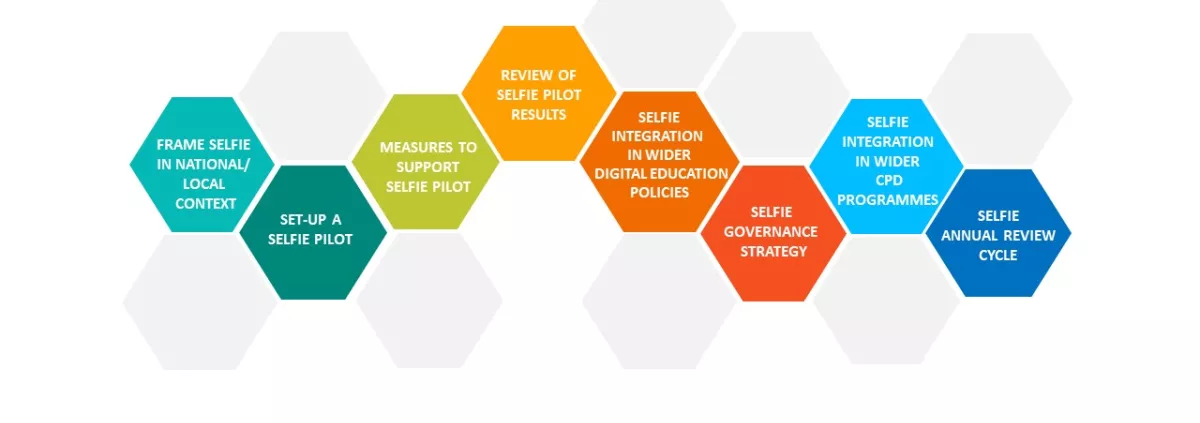The analysis of case studies in Italy, Portugal, Spain, Serbia, Turkey and interviews with key stakeholders informed the design of a methodology to scale-up and integrate the SELFIE tool at system level.
The free and online self-reflection tool “SELFIE” has been already subject of many posts and discussion on ETF Open Space, we know what we are talking about. What’s new is the availability of a comprehensive methodology for the uptake, at various levels of education and training systems.
On 23 November European Training Foundation and Joint Research Center of the European Commission organized a joint webinar to present preliminary findings from a joint study on “Scaling-up and integrating the SELFIE tool for the digital capacity of schools in education and training systems”.
The methodology identifies 8 key actions, highlights implications for policy and practice and offers 4 approaches based on 2 education and training system governance models, namely:
- Top-down vs. bottom-up
- Centralized vs. decentralized
For each of the four approaches, the methodology indicates key stakeholders to involve, actions to undertake and identified a set of common drivers and obstacles.

The ambition of framing the SELFIE tool in a system-wide perspective relies firstly on defining the policy intent for SELFIE integration in E&T system and on a clear statement about the rationale for the SELFIE intervention.
“When considering the scale-up of SELFIE at the system level, it is essential to put this tool for self-evaluation and reflective practice into the broader public policy context of quality assurance in schools”
Michael Lightfoot, International Education Development Consultant.
The recording of the presentation of the methodology of SELFIE integration into Education and training systems follows (by Stefania Bocconi, National Research Council of Italy, and Michael Lightfoot, International Education Development Consultant).
At the webinar, representatives of national education authorities shared their perspectives on using SELFIE at system and school level: from Italy (Pierluigi Vaglioni, Ministry of Education, University and Research), Portugal (Maria João Horta, Directorate-General for Education), Spain (César Herrero, INTEF, Ministry of Education and VET), Serbia (Ministry of Education, Science and Technological Development) and Turkey (Sümeyye Hatice, Ministry of National Education).
Officials from the European Commission, Georgi Dimitrov (DG EAC), Joao Santos (DG EMPL), Yves Punie (JRC) and Xavier Matheu de Cortada (ETF) framed the SEFLIE tool in mid-term perspective, in relation to the new European digital education action plan 2021-27 and VET recommendation and the ETF’s strategy 2020-27.
Two years since launch, the SELFIE tool is read to gear-up at system level and support the design and implementation of effective digital education reform. Even in 2021, ETF will continue to support the implementation of the SELFIE tool.
Joint ETF-JRC study on “Scaling-up and integrating the SELFIE tool for the digital capacity of schools in education and training systems”
The DRAFT report on the study cab be downloaded at the bottom of the page. The FINAL report is in the process of finalization and will be published by February 2021.
More on SELFIE: check out these recent blogs!
- #SELFIE_EU for Work-Based Learning: the pilot. A closer look at three ETF partner countries | Open Space (europa.eu)
- #SELFIE_EU comes to Work Based Learning | Open Space (europa.eu)

In relation to the attached study, special thanks go to 279 and Stefania Bocconi , to 1470 (EC-JRC), 2502 (EC-JRC) and the several experts and stakeholders in EU, Serbia and Turkey that contributed to the definition of the methodology. Many partner countries that have piloted SELFIE are now reflecting on how positioning it in the framework of their national digital education reforms. And the study can be a relevant and flexible road map.
It is such a great experience working jointly with the countries and all the ETF team and the experts.
Please log in or sign up to comment.